Basketball Drills - Breakdown Drills for Teaching the 2-3 Zone Defense
By Dr. James Gels, From the Coach’s Clipboard Basketball Playbook"Helping coaches coach better..."
Disclosure: This page contains affiliate links, which means that Coach's Clipboard receives a small commission (at no cost to you) if you make a purchase using these links.
The 2-3 zone defense is the most commonly used zone defense, designed to stop the inside game. But we still want pressure on the ball, on the perimeter. See Al Marshall's Aggressive 2-3 Zone Defense and 2-3 Zone Defense. Break down the 2-3 zone defense into drills, so that rotations become a habit, without players having to think about it.
Some players and coaches have the wrong notion that playing zone defense allows defenders to "rest" and loaf somewhat on defense. In fact, to play a really good zone defense, defenders have to work very hard, sprint in their rotations, move on the flight of the ball, and close-out on shooters with high hands. It's been said that "a good zone looks like a man (and a good man looks like a zone)."
Individual Skills Drills
Spend time on individual skills each day. These drills don't take a lot of practice time, but are important for developing the skill set necessary to play good zone defense.Stance Drill
In diagram A, all players line up four or five across (depending on your number of players) in rows. In the stance drill, players maintain the correct defensive stance for one minute. We want the hands and arms up and out, and feet shoulder width apart, weight on the balls of the feet (not flat-footed), knees bent and butt out.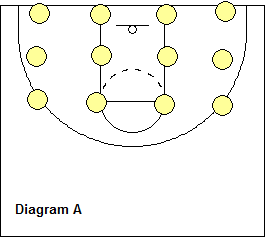
Surprisingly, it is not easy to hold this position for 60 seconds, as arm and leg fatigue creep in. Do this drill regularly to strengthen these muscles so that your defenders don't lose their defensive stance late in a possession. A zone defense looks "lazy" when players are tired, not sprinting, and hands are down. While players are holding this stance position, you can use this minute to talk to them about anything you want.
Slides Drill
In diagram B, after doing the stance drill for one minute, we do slides from side to side, again maintaining a good defensive stance with arms out and up, weight on the balls of the feet, and using good footwork, without crossing our feet. Start with players chattering their feet in place.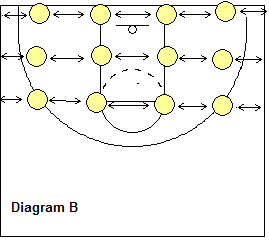
As the coach yells (or points) the instructions, "right" or "left", players slide accordingly and chattering again once they stop sliding. Make sure that when players slide, they do not lower their hands - hands should remain up and active. Do this for another minute.
Triangle "Anticipation - Deflection" Drill
In diagram C, break the team down into 4-player groups. The player in the middle gets in the defensive stance and tries to anticipate and deflect the pass. After receiving the pass, the passer should hold the ball for a couple counts to allow the defender to get set, and then can pass to either receiver. Do this drill so that each player gets 30-45 seconds of defending. This drill teaches defenders to read the passer and improves reaction time and quickness.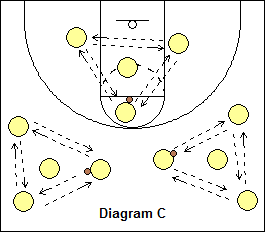
Ball Pressure Drill
In diagram D, each player has a partner. The defender is an arm's length from the offensive player, and he/she pressures the ball-handler with active hands, but without reaching in and fouling. No dribbling is permitted, and the offensive player must use his/her pivoting skills to protect the ball. Do this for 30 seconds and have players switch offense and defense.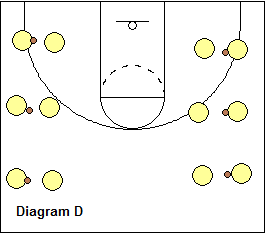
Contain the Dribbler Drill
In diagram E, each player again has a partner. The defender is an arm's length from the offensive player, and he/she pressures the ball-handler with active hands, but without reaching in and fouling. Dribbling is now permitted, when the coach yells "go", the offensive player dribbles either left or right for a few steps, as the defender moves his/her feet quickly to contain the dribbler. Have the offensive player dribble to the right and to the left several times, and then switch offense and defense.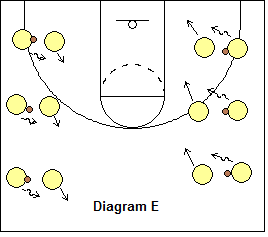
1-on-1 Full-Court Zig-Zag Drill
Each player has a partner of similar quickness and size. We use both sides of the floor and each two-some is confined to their side of the court. The offensive player tries to dribble the length of the court (staying on just half of the court), and attacks to score.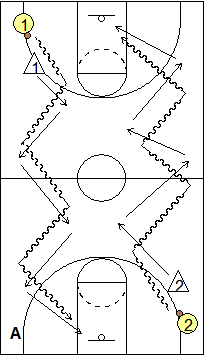
The defensive player tries to cut and turn the offensive player as many times as he/she can coming up the court, and then defends 1-on-1 at the basket. The defender must get low and move his/her feet quickly. Hands should be active, but the defender must not reach in and foul (there is even a variation wherein the defensive player must keep his hands behind his back at all times). If the defender gets beaten, he/she must turn and sprint to recover.
1-on-1 Full-Court Zig-Zag and Close-Out Drill
In diagrams B and C, again each player has a partner of similar quickness and size. We use both sides of the floor and each two-some is confined to their side of the court. The offensive player tries to dribble beyond half-court and then passes to a coach standing out-of-bounds along the sideline.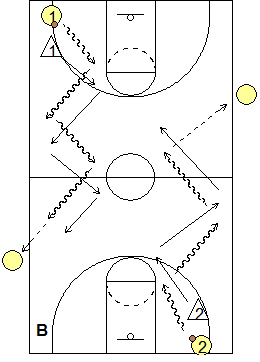
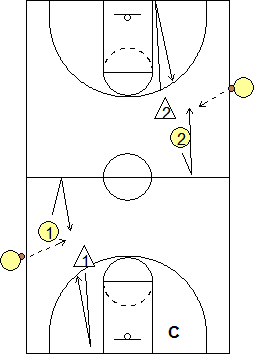
The defensive player tries to cut and turn the offensive player as many times as he/she can coming up the court. Once the pass is made to the coach on the sideline, the offensive player turns and sprints back to the half-court line and then back and receives the pass from the coach (diagram C above), while the defensive player sprints to the endline and then back to close-out on the ball. Both players then finish by playing 1-on-1.
Rotation and Defensive Close-Outs and Drills
The following drills help develop the necessary "habits" in rotating within the 2-3 zone defense, and closing out on the offense.On-Off Drill
In diagram F, as the ball is skip-passed to the left wing, X3 must first close-out with high hands, and then retreat back inside once X1 gets to the ball. This is called going "on and off" for the forward defender (X3). Defenders should sprint quickly as the ball is in the air, as soon as it leaves the passer's hands. Close-out with high hands in a good defensive stance.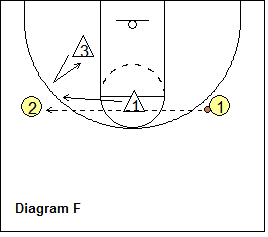
Skip-Pass to Corner Drill
In diagram G, as the ball is skip-passed to the left corner, X3 must close-out with high hands and defend the ball. This is his/her man and X3 does not go "on and off" in the corner, but stays with the ball. X1 drops inside to prevent a pass to the lane or elbow. Defenders sprint quickly as soon as the pass leaves the passer's hands. X3 closes-out with high hands in a good defensive stance.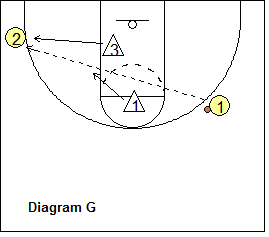
Forward's Wing and Corner Rotations Drill
Now we will drill how the outside low defender (forward) X4 defends the pass to the wing and to the corner. In diagram F2, as the ball is passed to the wing O2, X4 goes "on" (closes-out with high hands), and then retreats back inside ("off").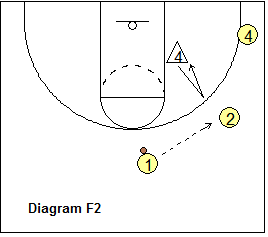
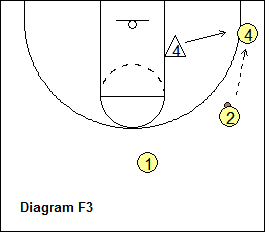
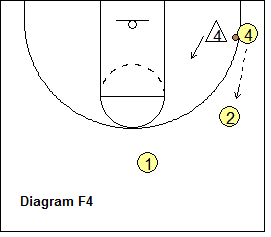
As the pass goes to the corner (diagram F3), X4 closes-out with high hands and stays with the ball in the corner. As the ball is passed back out to the wing O2 (diagram F4), X4 simply drops back inside, as normally X1 would already be on the ball and there is no need to go "on and off" here.
Forward's On-Off Rotations Drill
The next several diagrams H - K show how our two outside low defenders (forwards X3 and X4) rotate as the ball moves around on the perimeter. In diagram H, as the ball is passed from the point to the right wing, X4 goes "on and off" initially closing-out with high hands, and then retreating back inside. X3 moves inside the paint. As the ball is passed back to the point (diagram I), X3 moves back out to his/her usual neutral position.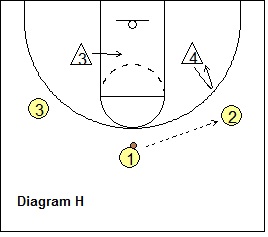
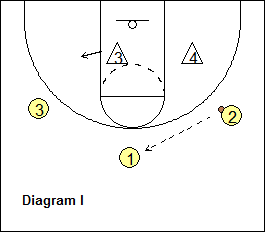
As the ball is passed from the point to the left wing (diagram J), X3 goes "on and off" initially closing-out with high hands, and then retreating back inside. X4 moves inside the paint. Diagram K shows a wing-to-wing skip-pass, with X4 going "on and off" and X3 dropping inside.
Spend a few minutes with the three offensive players passing the ball around on top while X3 and X4 rotate quickly, as soon as the ball is passed. In you have an assistant, use both ends of the court and make sure all of your inside defenders get enough repetitions.
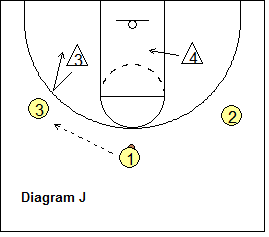
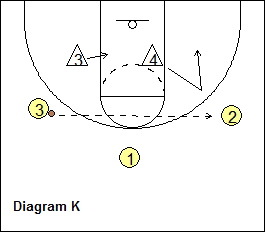
See the complete article in the members section.
Sign up now!
The complete article also includes:
- Defending the shooter... when to pressure the ball
- Guards and Forwards Skip-Pass Drill
- 3-on-4 Perimeter Passing Drill
- 4-on-4 with a High-Post Drill
- "Triangle" Wing-Corner-Post Drill
- Short-Corner to High-Post Dive Drill
- High-Post to Short-Corner Dive Drill
- 5-on-5 Drills
Related pages: